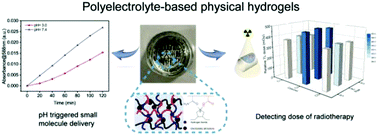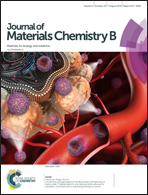Polyelectrolyte-based physical adhesive hydrogels with excellent mechanical properties for biomedical applications†
Abstract
Physically crosslinked hydrogels were synthesized by copolymerization of acrylamide and acrylic acid monomers in the presence of cationic polyelectrolyte polydimethyldiallylammonium chloride. The fully physically crosslinked hydrogel showed good mechanical properties and good adhesion with a variety of substrates. These advantages can be attributed to the homogeneous distribution of crosslinking points due to hierarchical hydrogen bonds and electrostatic attractions in the hydrogel networks. Furthermore, these non-covalent bonds provided an effective pathway to dissipate energy. The mechanical properties of the hydrogels can be easily tuned by changing the chemical composition and ratio of monomers. We further showed that the transparent hydrogels were cytocompatible, and can be used for biomedical applications, including pH-triggered small molecule delivery and hydrogel-based hybrids for detecting doses of radiotherapy.



 Please wait while we load your content...
Please wait while we load your content...